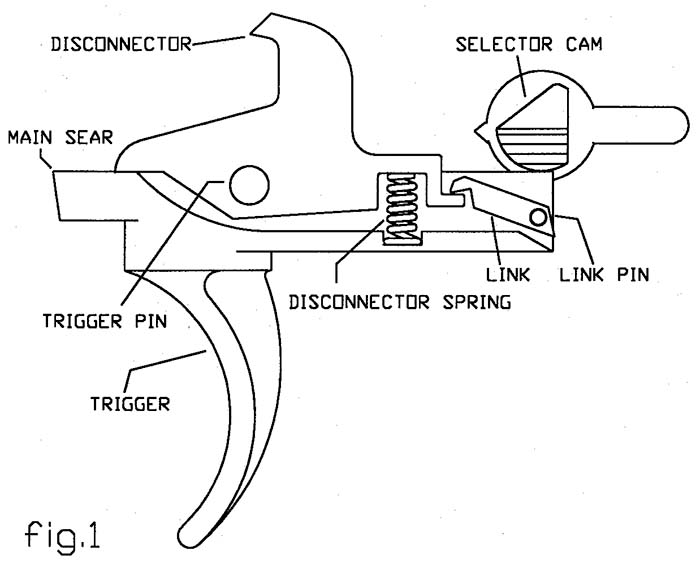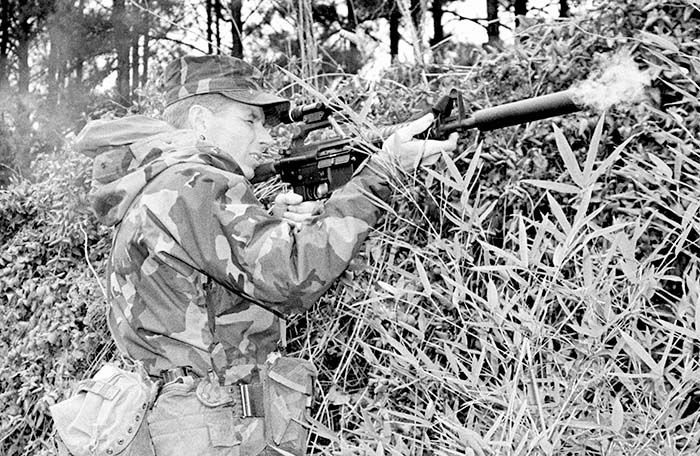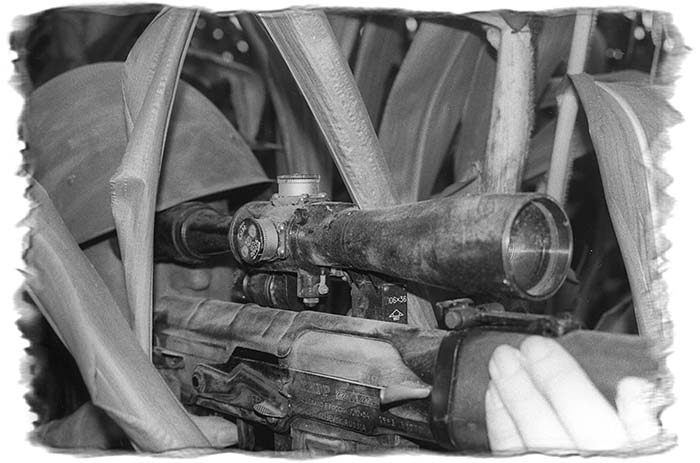By Al Paulson
Progress isn’t always a step in the right direction; sometimes so-called “progress” can be a step backwards. The three-round burst mechanism of the M16A2 represents a prime example of this phenomenon, since it was added to satisfy bureaucratic bean-counters and not the needs of the individual rifleman. This trigger is the weak link in a battle-proven and otherwise outstanding weapon. For bean-counters concerned about excessive ammunition consumption on the battlefield, a two-round burst mechanism would have made more sense since the third round out of an M16 commonly misses the target anyway. For individual operators concerned about their own survival, an even better solution would be to use a selector on this particular weapon that does not limit burst length, so the operator can decide the burst length instinctively based upon the situation at hand. But burst length is not the most serious flaw of this trigger mechanism. The design’s primary liability is that it delivers one of three considerably different trigger pulls every time the weapon is fired with the selector set to SEMI. This degrades the operator’s ability to place a shot accurately, and accurate shot placement is normally the point of the exercise… unless one needs to break an ambush or obtain temporary fire superiority to cover movement. If the ability to establish temporary fire superiority is a requirement, then I would argue that three-round burst control is less suitable than the ability to dump the entire magazine if the situation calls for it.
While an M16A1-style trigger provides the operator with more tactical options than the M16A2-style three-round burst trigger, the Steyr AUG full-auto trigger pack is an even better approach to the problem to my way of thinking. Pull the two-stage trigger rearward a little for semiautomatic fire and pull it back fully for full-auto fire. No time is wasted manipulating a selector when full-auto fire is required, and the placement of every shot of semiautomatic fire benefits from a trigger pull that does not vary from one round to the next. The AUG trigger could not be incorporated into an M16 without completely redesigning the weapon. But now owners of any M16 variant can have an AUG-style trigger that represents an outstanding upgrade to weapon performance and actually outperforms the AUG trigger in my opinion. It is called the Tactical Select Fire Trigger System.

Developed by Terry Soper of TAC, Inc. (2501 Walter Lane, Las Cruces, NM 88005; URL http://www.zianet.com/tsoper), the patented TAC Trigger System replaces the selector and trigger components in any M16 variant. U.S. Patent Number 5,623,114 was granted to Soper on April 22, 1997 (the patent can be seen by visiting IBM’s Intellectual Property Network; URL http://www.patents.ibm.com). The SAFE and SEMI functions on any M16 variant remain unchanged when using the TAC Trigger System, but when the selector is set to AUTO, the two-stage trigger functions in a manner similar to the Steyr AUG. Pull back a little for semiautomatic fire and pull back fully for full-auto fire. The TAC Trigger System has two sequential sear release points when the selector is on AUTO; the semiautomatic release point breaks at 5 pounds (2.3 kg) while the full-auto release point requires 8 pounds (3.6 kg) to trip.
Before taking a detailed look at the design and performance of the TAC Trigger System, it would be useful to take a brief look at the design and performance of the three-shot burst mechanism found on the M16A2.
M16A2 Three-Round Burst Trigger
The best thing one can say about the M16A2’s three-round burst mechanism is that it uses fewer components than the more intricate burst mechanism found on Heckler & Koch weapons. The HK design is a ratchet-counting mechanism that holds the sear away from the hammer until the selected number of rounds (2RB or 3RB) have been fired. The beauty of the HK design is that any interruption—such as releasing the trigger or emptying the magazine—resets the counter, so weapon always delivers the selected number of rounds as long as ammunition is available.
While the M16A2 burst mechanism is both robust and less complex, it does not reset the counter when the trigger is released. The so-called “interrupted” ratchet and pawl mechanism always picks up wherever the count was interrupted, so a given burst might consist of one, two or three rounds regardless of the tactical exigencies of the moment. Such unpredictability could cost lives.
Some years ago, several Alaska State Troopers were hunting a man who was on a gruesome killing spree that seemed something like a modern version of the Klondike’s Mad Trapper of the Rat River. A friend and his partner were riding in a helicopter armed with M16A1 rifles, when they spotted the killer. As they approached, the man on the ground shot the trooper he could see through the open door of the approaching helicopter and then ducked behind a small tree for cover. My friend leaned over the body of his dead partner and began to empty a full magazine of tracers from his M16A1, capturing the burst and walking it into the tree. While I’m a great believer in the efficacy of two-round bursts for solving most problems appropriate for full-auto fire from an individual (as opposed to crew-served) weapon, this tactical situation clearly called for a long burst. I should note that it commonly takes 5-7 rounds for an operator of an M16 to capture a long burst and begin to walk the burst back into a target, which was a serial killer in this case. The tree did not provide adequate cover for the killer, whose career abruptly ended in the Alaskan taiga after several days of appalling mayhem. The burst mechanism on an M16A2 would have seriously undermined my friend’s ability to solve that particular problem.
The late Gene Stoner shared my lack of enthusiasm for the M16A2’s burst mechanism. Gene once confided to me, “Engineering a three-round burst into the M16 gives the worst possible burst length for this particular weapon.”
From a strictly engineering rather than an operator’s point of view, the nine-component burst control mechanism now used on the M16A2 is well designed. It is both simple and durable. The mechanism is based upon a six-notch ratchet with an overriding clutch that provides two three-round burst cycles per 360 degree revolution of the ratchet. Each cycling of the hammer turns the rotating cam 60 degrees. Assuming the cycle starts with the pawl in the first shallow notch (the so-called “stage one” notch), the third hammer cycle will move the ratchet a total of 180 degrees to a much deeper notch. The resulting greater movement of the trigger pawl allows the hammer to fall from the auto sear to the burst disconnector, which holds the hammer in place, thereby interrupting the full-auto burst.
From an operator’s point of view, the first thing one notices about the M16A2 three-round burst trigger is that the trigger pull with the selector set on AUTO is about 1 pound (0.45 kg) heavier than the M16A1 trigger. This is because the burst control requires two disconnectors and springs. The burst disconnector cycles the burst cam whether the selector is set to SEMI or AUTO. The design of the burst control’s rotating cam is such that it increases the trigger pull from a minimum of about 7.5 pounds (3.4 kg) to a maximum of about 9.0 pounds (4.1 kg), as the ratchet mechanism cycles from stage one to stage three. Setting the selector to AUTO prevents the semiautomatic disconnector from functioning.
In an age of dwindling marksmanship training in many military services, this variable trigger pull may not seem significant. But this is a proverbial thorn in the side of a rifleman worthy of the name. One of my mentors, Col. Jeff Cooper, has observed that “I have come to the conclusion that trigger control is the heart of the matter… and good trigger action… is the most important single aspect of hitting what you want to shoot at.” Variable trigger pull tends to negate other attributes of the M16A2 (such as adjustable 800 meter sights and heavy contour barrel) designed to improve the effective range of the weapon.
This is not armchair philosophizing. The U.S. Marine Corps, which continues to value rifle marksmanship as the cornerstone of combat effectiveness, experienced a drop in rifle scores when they began using the M16A2 with three-round burst mechanism, according to one published source. This drop in scores was attributed to the inferior and variable trigger pull delivered by the burst mechanism. Furthermore, a Marine unit participating in the Gulf War actually asked permission to deactivate the burst feature on their M16A2 rifles by bending the ratchet control pawl so it could not engage the burst cam. Not only did these Marines get permission, it appears that this field-expedient modification was made by others during Operation Desert Storm.
I should note, however, that many authorities make the case that “good trigger action is not important in weapons intended for combat” or even for the taking of dangerous game. I do not agree. Confidence in one’s ability to place shots well, and to do so quickly, are important factors in the equation that determines an individual’s likelihood of solving a problem under stress—whether that problem is stopping an armed Homo sapiens or a charging Ursus arctos horribilus. A good trigger not only makes a good rifleman more accurate, it makes him distinctly faster. A good trigger, therefore, should make anyone with a modicum of skill a more confident and more effective problem-solver. I believe the Tac Trigger System is a giant step in the right direction for making the M16A2 both more accurate and faster on target.

TAC Two-Stage Trigger
The drop-in conversion kit for the two-stage TAC Trigger System consists of a modified M16 trigger, disconnector, disconnector spring with transfer link, stainless steel pin, and selector. The three-round burst mechanism will be removed during the installation process.
Production of the Tac Trigger System is run by TAC V.P. John Mathis, who is a retired NASA ordnance specialist. The TAC trigger is manufactured from a “green” casting that is CNC milled and drilled, case hardened, and then blued. The TAC trigger includes a recess milled to accommodate a transfer link, which is CNC machined from tool steel. The rear of the trigger is drilled to accept the link pivot pin, which is stainless steel. The disconnector is CNC milled to shape from a stock unit; changes include shortening and reshaping the disconnector extension at the rear of the piece. A stock selector is CNC milled to ensure enough trigger motion and to provide the necessary contact point with the link. The stock disconnector spring is used, but its spring rate can be tailored to adjust the full-auto transition point if necessary. The kit comes with detailed installation instructions, so it is not necessary to be a gunsmith or armorer to install the system. I should note that TAC, Inc. will entertain licensing production to OEMs.
The one point I should emphasize, however, relates to installing this kit on a weapon with a three-round burst control. It is absolutely essential to remove and not reinstall the burst cam and spring. While no modifications are made to the receiver, end-users other than private collectors may wish to engrave a “+” or “+ SEMI” after the “AUTO” selector label.
The weapon with TAC trigger system installed works just like an unmodified weapon when the modified selector is set to SAFE or SEMI.
When the selector is set on AUTO, semiautomatic fire is achieved by pulling the TAC trigger back no farther than its median position. This enables the modified disconnector to perform its hammer engagement function, since the disconnector is not engaged by the selector cam. To obtain full-auto fire, the operator simply pulls the trigger to its extreme rearward position. The rear of the trigger pivots upward until the transfer link engages the selector cam. This pushes the distal link of the transfer link downward, thereby exerting a downward pressure on the disconnector extension. The disconnector pivots rearward, which prevents engagement of the hammer and middle hammer hook. The auto sear engages the upper hammer hook until it is struck by the forward-moving bolt carrier. This strike releases the hammer to fire another round. Full-auto fire continues until the trigger is released, which enables the lower hammer notch to re-engage the trigger nose, ending the full-auto burst.
Learning to use the Tac Trigger System is both easy and instinctive. With the selector set on AUTO, the operator can instantly choose to fire a single round or a burst of any length without the distraction and time necessary to reposition the selector, which takes about 1/2 second. This capability can pay substantial tactical dividends. Maintenance requirements are improved because the TAC system eliminates the two weak links of the three-round burst system: the burst cam and the burst cam clutch spring. The TAC system requires no special maintenance.
While the Austrian and Australian armies and a number of U.S. agencies are quite happy with the Steyr AUG’s two-stage trigger, one U.S. Army wag suggested that “our troops are not smart enough to handle a two-stage trigger” on an M16. I categorically disagree. Transition to this trigger would be fast and instinctive for anyone capable of tying shoelaces, let alone trained soldiers.
A final footnote relates to the use of the TAC Trigger System by private collectors. The TAC system cannot be used to convert a semiautomatic rifle into a full-auto weapon, so BATF has issued a ruling letter authorizing the distribution of the system for the purpose of retrofitting machine guns on the registry. The system will work on all Colt-brand and Colt-spec 5.56mm and 9mm variants. The system may or may not work in a given aftermarket receiver, depending on how far it varies from Colt specifications. The TAC Trigger System will also work in guns converted to full auto with registered drop-in auto sears, but it will not work with so-called Lightning Links. The TAC trigger will even work with .22 LR and 9mm conversion kits. If demand warrants, the patented trigger will also be produced for Kalashnikov-based weapons such as the AK47, AKM and Galil.

The Bottom Line
I believe the TAC Trigger System is an excellent and cost-effective upgrade for making the M16A2 and M4 both more accurate and faster on target when the selector is set to SEMI. With the selector set to AUTO, the weapon delivers semiautomatic fire or reliable bursts of any length the operator decides, rather than delivering a burst of arbitrary length decided—not by the operator—but by the happenstance of ratchet orientation within the rifle’s burst-control mechanism. The capricious nature of the three-round burst mechanism clearly subverts the operator’s full control of the weapon and therefore subverts his ability to control the tactical environment. Furthermore, the TAC system saves a potentially invaluable 1/2 second if an operator suddenly finds the need to go from semiautomatic to full-auto fire. This latter feature of TAC’s two-stage trigger would make it a valuable upgrade for the M16A1 and its variants, as well. Accuracy and speed are essential ingredients to the skilled use of arms, and the TAC Trigger System delivers
| This article first appeared in Small Arms Review V3N6 (March 2000) |











